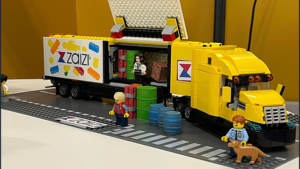
Service design in the public sector — webinar Q&A
As part of Digital Leaders Week 2021, Zaizi’s senior service designer Mick Angel gave a presentation titled ‘How can service design help drive value in public sector projects?’
It prompted many questions about service design both during and after the webinar, not all of which Mick had time to tackle during the talk itself.
Below, Mick addresses and expands on some of the questions asked.
Why is service design so big now and is it a gimmick? Why do you think that service design is talked about a lot but there are not many service designers in the digital departments?
Mick Angel: Service design is not a gimmick. The idea of service design is a fantastic one – “let’s really unpick services, let’s test them and build fantastic services”. Who wouldn’t want that? When it works, it’s amazing — true societal value is created and citizens get better services.
It’s talked about a lot because it seems to be a panacea, fixing every problem. And that’s why it sometimes feels oversold.
Many services aren’t actually being unpicked or transformed and so the service design function struggles to deliver value. If you already have a working service and no possibility of transformation, perhaps there are other ways to improve without needing to do ‘full’ service design techniques? Like lean continuous improvement, for example.
If you’re a cash-strapped local council, you might not have the scope to unpick a service and start from scratch. But you can improve it over time, piecemeal. That’s where continuous improvement might be a better approach. The work could still be led by a service designer but the outcome would be an improved service, rather than a redesigned one.
It’s best to use service design from the start of a project, but the principles of service design can be applied at most stages
Mick Angel
That’s the tension between the promise of service design – to unpick services and build them better from the ground up, fully transforming them – versus the reality for many organisations where it’s quieter, incremental service design with a small ‘s’ and small ‘d’.
Sometimes it is about small incremental benefits and not the big grand designs that get all the headlines and are talked about.
There is a tendency to think service designers only provide value in those major transformation projects. And seeing that many projects aren’t doing proper transformations, there’s a feeling that service designers aren’t needed.
It’s best to use service design from the start of a project – as I’ve mentioned in the talk – but the principles of service design can be applied at most stages and will still provide some value, even in non-transformational projects. The trick is to be clear and honest about what kind of project it is and what’s being expected. Make sure sponsors know where the project sits on the continuum between “wholesale transformation” and “piecemeal incremental improvement”, for example.
Many digital departments still have a ‘product mindset’ — you’re more likely to find designers working on products rather than services — and so it’s felt ‘service designers aren’t needed. Also if service designers do exist in companies, they’re usually spread thinly around organisations and that affects quality and also how visible they are. Service design roles are tough to fill due to the multidisciplinary background needed. The upshot is that although service design gets a lot of attention, there aren’t enough experienced service designers to go round.
What advice would you have for doing discovery for the replacement of an existing service?
The first step is to understand what “replacement” means for the project. There’s a lot of work that’s done under the guise of transformation but it’s actually mere digitisation. The efficiency benefits stakeholders see is gained by simply digitising a process. In a way the process improves “coincidentally” as a result of moving digital — a digital process is typically more efficient than a paper process. So simply digitising creates some value but this should be the minimum and not the sole aim.
Try to understand what the expected change is meant to be. You don’t have to know the detail just yet but find out what they’re trying to do. Are they trying to transform (with a big T) the service? Or are they saying, actually, the scope is very small, the solutions have already been chosen and you’ve got a hard deadline in six months to do something?
In that case, set your expectations with the stakeholder and explain what can be achieved and what benefits they’ll see.
How do you shift a leadership mindset to place greater importance on service design, especially when the need to change and design is driven by COVID rather than executive decision?
Often the leadership’s mindset is taken up by the power structures that exist around existing services. The leadership’s identity and sense of self can be based on the service they’re in charge of.
What service design needs to do is collaborate, unpick what’s there and push outwards.
It’s about having those awkward conversations with leadership. Their value may be tied up in the ‘as-is’ service but it’s pointing out that the ‘to-be’ service might have a different value metric. They may be in charge or become merely one of the many stakeholders in the new service, for example.
So moving everyone to be more open and collaborative, and agreeing on the common value drivers, is part of the service designer’s job. Sounds like a platitude, but it can help understand what drivers might exist outside of the mere reactionary changes around COVID.
What is the most common blocker to getting value out of service design, specifically in local and central government?
One common blocker is getting service design in later rather than earlier. I mention this in my talk, but it’s important to get service design thinking involved so it can frame the problem, not just the solution.
Another common blocker comes from sponsors pitching the project as “transformation” to get the funding, and then once underway treating it as a simple improvement project. The project might even have all the hallmarks of a transformation project such as a full-time service designer and big transformational talk at the start. But in reality, the solution’s pre-selected, a supplier or development team has already started work and it’s all constrained into “we need what exists now, but better.”
Lastly, one way I’ve seen value erode in government projects is to treat service design or discovery as a “tick-box” exercise. Service design and discovery should be challenging the assumptions and fundamentals of the service, unpicking it and being bold. If it’s not doing that, then the whole value creation process will be blocked.
What are typical service design deliverables and what does the output look like?
In most projects, the deliverables will consist of lots of collaborative workspaces, such as Mural boards or Miro boards.
On a high level, many outputs can look like workshops — stakeholder workshops, value-mapping workshops, research workshops. A service designer’s job involves planning, design, output, synthesis and post-workshop activities. You’ll see a lot of these collaborative spaces as artefacts. Some of these include affinity maps, value maps and journey maps. These are done in collaboration with the wider team.
Ultimately, a lot of the work manifests itself as blueprints to evidence what the service journey is. If a service designer has done their job properly, they look fantastic. A lot of work and thought goes into producing these blueprints. From just looking at it, it’s clear that a lot of dots – all the touchpoints and events in a service – have been joined together.
But it’s important to state that actual value isn’t in the printed blueprint. The work, effort, collaboration and workshops involved in designing and agreeing on the blueprint are the most important elements. That’s where the value is.
Why are there so many product managers if “everything is a service”?
Many companies start as product companies and over time end up providing services. Sometimes this change happens by accident and sometimes by design. Perhaps we are living in an endless cyclic transition period, as structures are set up in new organisations to deal with products, and they slowly turn into service structures over time as the organisation matures.
Service power structures can be more powerful than product ones, as they are likely to cut across political lines within organisations. Services can force a “cross-silo” way of looking at the value an organisation brings its audience and occasionally this approach goes against the traditional way organisations think.
For example, think about Pret a Manger – definitely a product company. They have a global “head of coffee” – a product manager with a product focus. You can find that person on LinkedIn, and their title really is “Head of Coffee”.
But for some customers who shop at Pret, coffee is just one aspect of the service experience. If there was a global head of customer experience at Pret (service focus), the role could complement the Head of Coffee (product focus). For the experience, coffee is just one aspect and perhaps a small aspect at that. For the head of coffee, it’s everything.
Service power structures can be more powerful than product ones, as they are likely to cut across political lines within organisations
Mick Angel
A product focus is powerful. Product managers help improve a specific product through a tunnel-vision focus on that and that alone. For the head of coffee at Pret, their task every day is to improve coffee, get more people buying coffee, make coffee more valuable to customers and the organisation.
Lastly, perhaps a more simple answer is that service journeys are sometimes intangible and vague and so it’s easier for organisations to recruit and structure themselves around products. For example, BT sells broadband packages, which sound a bit like products and are treated like products. In reality, broadband packages are services. But it’s much easier to think and sell them as discrete and modular products than variations of an intangible service contract.
Related content
-

The great legacy escape: Ditch the spreadsheets, drop the paper
-

The great legacy escape: How outdated systems and processes still hold government back
-

GDS’s research into AI in government – and how to deliver real value
-

From ScanApp to Lego demos — What you need to know about Security & Policing 2025
